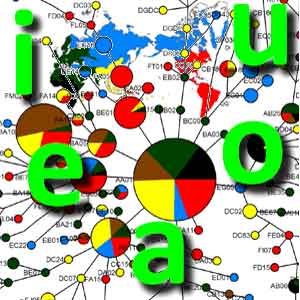 COM.on C.A.2:e7/42-51
Online published on Nov.
27, 2008.
COM.on C.A.2:e7/42-51
Online published on Nov.
27, 2008.doi:10.4236/coca.2008.21007
 COM.on C.A.2:e7/42-51
Online published on Nov.
27, 2008.
COM.on C.A.2:e7/42-51
Online published on Nov.
27, 2008.Recieved: Nov.24,2008 Accepted: Nov.27,2008 Corresponding: LiHui.Fudan@gmail.com
人类语言基本元音体系的多样性分析
李辉
复旦大学生命科学学院现代人类学教育部重点实验室,上海 200433; 耶鲁大学医学院遗传学系人类多态性研究实验室,美国 康州 新港 06520
摘要:人类语言的各类音素中,元音相对比较简单,在全世界语种间的多样性也比较容易分析。本文收集了世界主要语系的621种语言和方言的元音体系,分析了基本元音 音位总量和元音音系类型的多样性分布。基本元音音位总量在世界语言中从2到20不等,其地理分布很不均衡,体现为欧亚大陆的语言基本元音总量整体偏大,其中日耳曼语和吴语最大,而美洲和澳洲则整体偏小。通过把音 位转化为数字,世界语言的元音音系多样性可以用遗传学中线粒体多态性的网络结构分析方法。网络结构分析发现,最常见的aeiou的五元音音系类型可能是人类语言最原始的元音音系,处于网络结构的唯一扩散中心。其他音系类型可能都是从五元音音系经历不同的过程演化而成的。语音数字化对于语言学的统计分析有启发意义。
关键词:元音 音位;多样性;网络结构分析;地理分布
收稿日期:2008年11月24日 修回日期:2008年11月27日 联系人:李辉LiHui.Fudan@gmail.com
全文链接 Full text: [PDF]
附表1 世界主要语种的基本单元音
Supplement table 1 The basic vowel systems of the major languages in the world [XLS]
参考文献 References
1.Ladefoged P (1993) A Course in Phonetics (Third Edition). Fort Worth: Harcourt Brace Jovanovich. 197.
2.陈炳藻(1980)从词汇上的统计论《红楼梦》作者的问题.首届国际《红楼梦》研讨会.美国威斯康星大学,1980年6月16-20日.
3.Bandelt HJ, Forster P, Rohl A (1999) Median-joining networks for inferring intraspecific phylogenies. Mol Biol Evol 16:37-48.
4.IPA(1999) Handbook of the International Phonetic Association. New York, NY : Cambridge University Press.
5.Bao ZM (1999) The structure of tone. New York: Oxford University Press.
6.Benedict PK(1984)Austro-Tai Parallel, A Tonal Chamic Language on Hainan. Computational Analyses of Asian and African Language 22:83-86.
7.Daniels PT, Bright W (1996) The World's Writing Systems. New York, NY: Oxford University Press.
8.Wright W (1971) A Grammar of the Arabic Language (3rd Ed). New York, NY: Cambridge University Press.
9.Hewitt BG (1979) Abkhaz. London: Routledge.
10.Maddieson I (2008) Vowel Quality Inventories. In: Haspelmath M, Dryer MS, Gil D, Comrie B (eds) The World Atlas of Language Structures Online. Munich: Max Planck Digital Library.
11.van Oostendorp M (1999) Schwa in Phonological Theory. In: Cheng L, Sybesma R (eds) The Second Glot International State-of-the-Article Book. New York: Mouton de Gruyter. 431-462. ?
12. Garlén C (1988) Svenskans fonologi. Lund, Sweden: Studenlitteratur.
13. 钱乃荣(1992) 当代吴语研究.上海:上海教育出版社.
14. 金二新(2008)金汇续志(1985-2002.5),第二十一章社会生活,第六节方言.上海:上海辞书出版社.419-422.
15. Güldemann T,Vossen R (2000) Khoisan. In: Heine B, Nurse D (eds) African languages: an introduction. Cambridge: Cambridge University Press.99-122.
16. Li H, Cai X, Winograd-Cort ER, Wen B, Cheng X, Qin Z, Liu W, Liu Y, Pan S, Qian J, Tan CC, Jin L (2007) Mitochondrial DNA diversity and population differentiation in southern East Asia. Am J Phys Anthropol 134:481-488.
17. Bengtson JD (2001) Genetic and Cultural Linguistic Links between Burushaski and the Caucasian Languages and Basque. The 3rd Harvard Round Table on Ethnogenesis of South and Central Asia, Harvard University, May 13, 2001.
18. Casule I (2003) Evidence for the Indo-European Laryngeals in Burushaski and Its Genetic Affiliation with Indo-European. J Indoeuropean Studies 31: 21-86.
19. Bomhard AR, Kerns JC(1994) The Nostratic Macrofamily: A Study in Distant Linguistic Relationship. Berlin, New York, and Amsterdam: Mouton de Gruyter.
20. Krishnamurti B (2003) The Dravidian Languages. Cambridge, UK: Cambridge University Press.
21. Breen G (2001) The wonders of Arandic phonology. In: Simpson J, Nash D, Laughren M, Austin P, Alpher B (Eds) Forty Years On: Ken Hale and Australian Languages. Canberra: Pacific Linguistics. 45-69.
22. Leeding VJ (1989) Anindilyakwa phonology and morphology. PhD dissertation, University of Sydney.
23. 李辉(2008)兰坪县普米语拉丁字母拼写方案设计和应用.第二届全国少数民族青年自然语言处理学术研讨会.安徽,合肥,2008年10月7-9日. 37-43.
24. 欧亨元(2004)侗汉词典. 北京: 民族出版社.
25. Kaplan LD (1981) Phonological Issues in North Alaskan Inupiaq. Alaska Native Language Center research papers, no. 6. Fairbanks, Alaska: Alaska Native Language Center.
26. Cusihuamán A (2001) Gramática Quechua Cuzco-Collao. Centro de Estudios Regionales Andinos "Bartolomé de Las Casas".